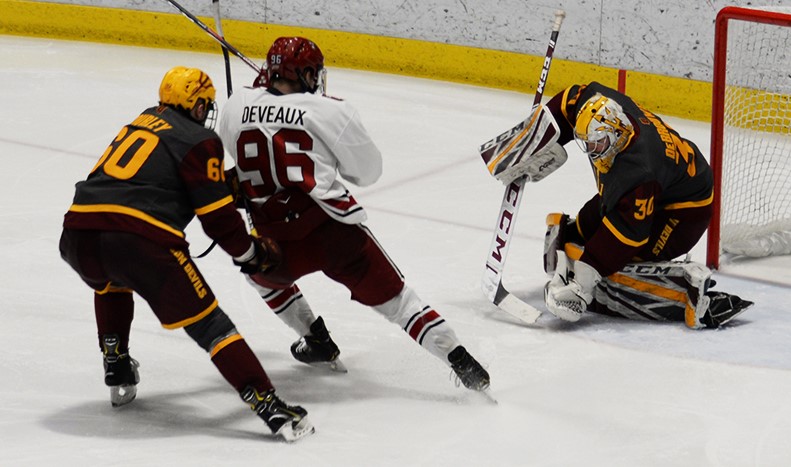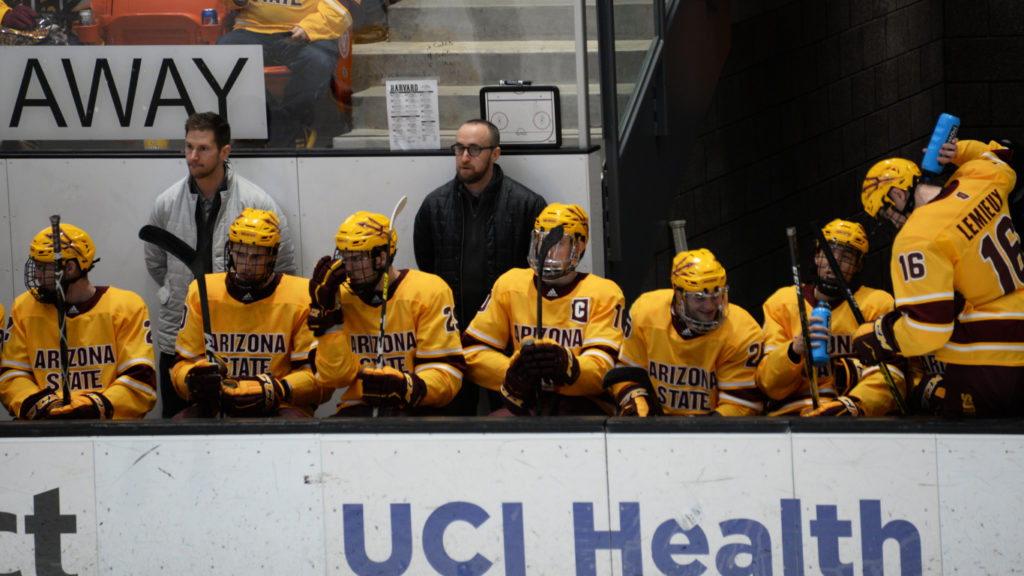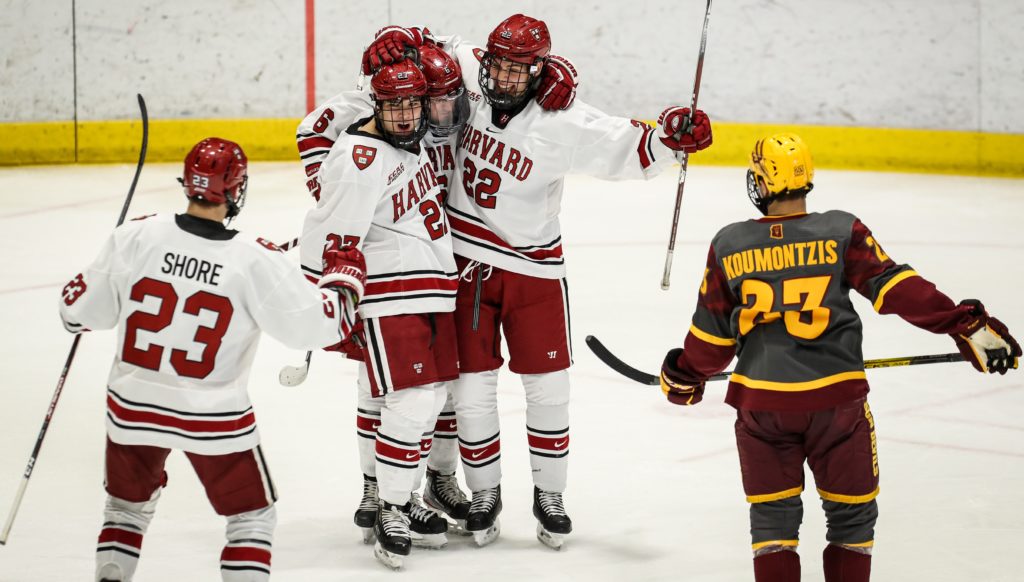
California is known for its college baseball, basketball and football traditions.
Over the weekend, it hosted another college sports event that Southern California hockey fans hope will spark a new tradition on ice.
For the first time since Maine defeated New Hampshire to capture the 1999 NCAA Division I hockey title at Arrowhead Pond of Anaheim, NCAA college hockey returned to California.
Harvard, in conjunction with the Anaheim Ducks, organized and hosted the SoCal Clash, a two-game weekend series at Irvine’s Great Park Ice and FivePoint Arena between No. 16 Arizona State and the No. 17-ranked Crimson. With the series, Arizona State, Harvard and the Ducks aimed to show hockey fans in Southern California the high level of competition featured in NCAA hockey.
The long-term goal is that a local university might someday start its own NCAA hockey program.
Harvard defeated Arizona State 4-1 Saturday behind a strong performance by goaltender Mitchell Gibson and a goal by 2017 Ducks draft pick Jack Badini. Sunday, the Sun Devils erased a three-goal deficit to force a 4-4 tie with the Crimson, but Harvard prevailed in an exhibition 3-on-3 overtime to earn the unofficial 5-4 victory.
Saturday’s matchup drew a sellout crowd of 2100 fans in addition to 400 standing room tickets totaling 2,500 spectators, according to arena management. Sunday’s matinee game drew nearly 1800 fans.
Art Trottier, vice president of The Rinks — the operator of the Ducks-owned ice facilities in Southern California — sees the SoCal Clash as an important event to grow ice hockey in the region.
“I think a lot of kids have not seen a Division I college hockey game in person,” he said. “A lot of kids’ goals are to play in the NHL that was all of our goals growing up us a kid, but I think one of the pathways is U.S. colleges. This is a great way to see the quality of a Division I college hockey game in person.”
Many Arizona State and Harvard alumni attended the weekend series, as did youth hockey players.
Eleven-year-old Grayson Turk, who plays for Empire Hockey Club in Ontario, Calif., enjoyed the high-flying games both teams played over the weekend.
“This is my first college hockey game,” he said. “My favorite part of the game is that there’s a lot of scoring.”
Jack Shade, a 12-year-old youth player for the California Wave in Artesia, Calif., said the college game rivaled professional hockey in excitement.
“It’s pretty comparable, and it’s a lot of fun to watch,” he said.
When asked if they would someday like to play college hockey for a school like USC or UCLA, both answered with a resounding, “Yes!”
No California school fields an NCAA hockey team, but California is becoming a fertile recruiting ground for college hockey programs around the nation.
According to College Hockey Inc., 40 Californians play on Division I college hockey teams in the United States this season. That’s the ninth-most nationally.
As of the 2018-19 season, California also has the fifth-most players registered with USA Hockey at 32,696.
Arizona State coach Greg Powers, whose team has one of the nation’s most rigorous travel schedules, aims to motivate other West Coast schools to join the Sun Devils in NCAA competition.
“We are trying to grow the game out west,” he said. “There’s no better way to do it than in a market like Southern California against an opponent like Harvard. To develop natural regional rivals in our sport would be very healthy. That’s the idea, to show other Pac-12 schools that they can add this sport and be successful at it rather quickly and develop it into a revenue sport.”

For Arizona State senior captain Brinson Pasichnuk, the series’ popularity was a shock.
“I always wanted to play in California in my college career,” he said. “The fans really surprised me. I had no idea it was going to be that crazy in there. The atmosphere was awesome.”
Harvard organized the event, which had initially been pitched as a four-team tournament combined with a youth showcase but eventually shrank to the back-to-back series played over the weekend.
Still, with the SoCal Clash’s popularity, Harvard’s director of hockey operations Sean O’Brien hopes the Crimson will continue to host and grow the event or something similar in Southern California.
“In the future, that’s something we’d talk with the facility about,” he said. “I think there’s a big opportunity for an event around the college game.”
Harvard coach and former Duck and Los Angeles King Ted Donato noticed hockey’s growth in the region since his playing days.
“I was double-taking walking into the rink,” he said. “There had to be a couple-hundred kids doing public skating. There were kids in hockey equipment. There were girls in hockey equipment. It warms the soul. Hopefully, some people came out of this weekend saying, ‘Hey you know what, this would be really neat if we could have some college hockey in California to come watch at this level.'”
Over 20 California schools, including those in the Pac-12, field ACHA or “club” hockey teams, but the SoCal Clash is an important step to try to entice a local University to undertake an NCAA program.
Trottier thinks Great Park Ice is a perfect home arena for a future local NCAA hockey team.
“In the back of our minds I think we have an ideal venue for a Division I hockey program in Southern California,” he said. “I think it’s sparked some interest.”

The NHL also hopes the SoCal Clash will have a lasting impact on California hockey.
That includes former Princeton player, L.A. King, and current NHL vice president of business development and international growth, Kevin Westgarth.
Westgarth’s college experience gives him firsthand knowledge of the importance of college hockey in the sport’s growth.
“The access to the players is a huge one,” Westgarth said. “You still see it everywhere. For me, it was skate with the Tigers, getting a chance to interact with kids in the community.”
For youth players and fans, meeting a college hockey player can be as thrilling as meeting a pro. That became obvious after each game when children and adults lined up in the arena lobby to meet the players and collect their autographs.
The NHL sees college hockey in the area as beneficial for its growth rather than another competitor. That is why it’s been involved in studies at schools throughout the nation to gauge the feasibility of starting new NCAA hockey programs.
“We’ve been looking at a number of schools, some of which are confidentially exploring the idea,” Westgarth said. “We are very excited at the prospect of getting more hockey out to the West Coast, and certainly the Pac-12 would be a huge win for everybody in the college hockey world, and I think at the NHL level as well.”
Judging by the SoCalClash’s attendance and the fans’ reaction to the series between Arizona State and Harvard, there won’t be another 20-year gap between NCAA hockey games played in California.
The question is, “How long until those games feature a California school?”
Local hockey fans hope the answer to that question is, “Not long.”
Comments are closed.